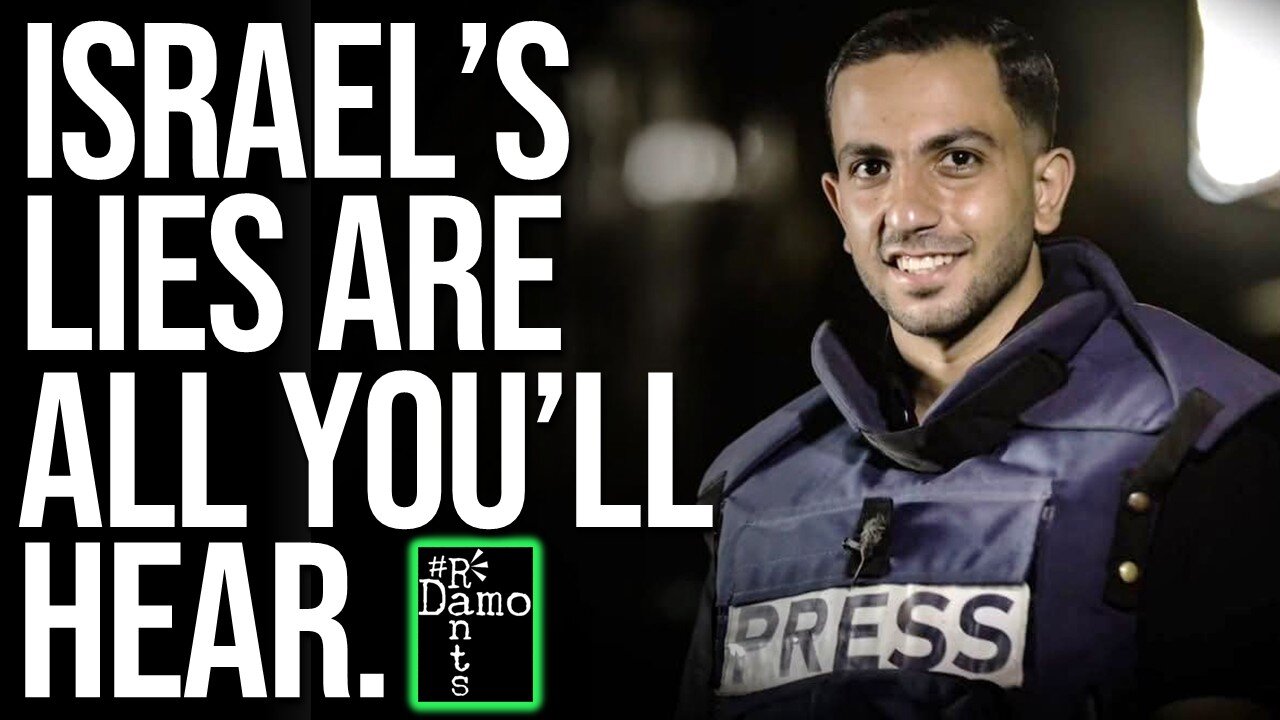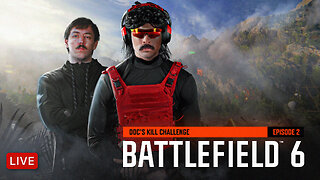Premium Only Content

Israel’s Missiles Target Gaza’s Press — So Only Its Lies Will Survive
Right, so Israel has always feared the truth more than any weapon in Gaza. Bombs can flatten buildings, but cameras can shatter their lies to devastating effect — and that is why the bodies piling up in this war aren’t just those of the slaughtered civilians, but the people holding the microphones and the lenses. For nearly two years, Israel has made Gaza the most lethal place on Earth to be a journalist, not by accident, not as “collateral damage,” but by cold calculation. Now, with the assassination of Anas al-Sharif — one of the last voices still broadcasting from inside the rubble — the mask has slipped entirely. This is not war reporting. This is war against reporting, waged with missiles instead of press releases, and its aim is nothing less than to blind the world before the final act of genocide, the final push of a genocidal state that wants you blinded by their propaganda and not armed with the truth. That is why these journalists are dying, that is why this matters so much and as rubbish as our own media are, real journalism still exists and if we can’t see the difference, if we can’t find it within ourselves to call this out and stand against it too, then we won’t realise what we’ve lost until its already gone.
Right, so on the night of 10 August, a missile fired by the Israeli military struck a clearly marked press tent outside Gaza’s al-Shifa Hospital. The location was well known as a gathering point for members of the press covering the siege. Inside were several members of an Al Jazeera crew, among them one of the last and most recognisable Palestinian journalists still broadcasting from the enclave: Anas al-Sharif. Al Jazeera reported the following day that at least five of its staff died instantly in the blast, including al-Sharif. He had been “one of the few prominent correspondents still able to broadcast from inside Gaza” after nearly two years of war. The Washington Post noted that his death was likely to “further silence critical coverage” from within Gaza, just as Israel prepared its long-threatened “final push” into the territory.
This was not an unforeseen risk on al-Sharif’s part either, he knew the dangers of what he was doing and did it anyway. Bravery like that is second to none and the same goes for all journalists who have been and still are reporting from Gaza. As Quds News Network reported amongst others, al-Sharif had received direct threats from Israeli authorities warning him to stop filming certain incidents and avoid broadcasting footage that undermined the official military narrative. Analysts cited in that coverage argued that his reporting, widely viewed across the Arab world and beyond, made him a dangerous witness in the eyes of the Israeli government—not because of any combat role, but because of his ability to document, in real time, the human consequences of Israel’s actions. His broadcasts and posts frequently contradicted Israeli claims about the precision of strikes or the nature of the targets hit, thereby challenging the official story in the most public way possible.
The events that followed his death matched a grim pattern familiar to those tracking the targeting of journalists in Gaza. Within hours, Israeli-linked channels began circulating fabricated messages purporting to show al-Sharif as a Hamas operative, as reported by Skwawkbox. This post-strike smear campaign attempted to retroactively justify the killing by framing him as a legitimate target under the laws of war—a tactic that not only fails the legal standard for removing civilian protections, but which also adds a layer of information warfare to the physical attack.
Al-Sharif’s death is not simply another tragedy in a long war. It is both a deeply personal loss and a strategic moment that reveals the depth of depravity to which Israel will go to blind the world to what is happening in Gaza. His killing is part of a pattern that stretches across the entire conflict, one aimed at erasing independent witnesses so that Israel can regain control over a narrative it has increasingly struggled to contain.
The killing of al-Sharif brought the known death toll of journalists in Gaza since October 2023 to more than 230, making it “the deadliest conflict for journalists ever recorded.” These figures dwarf those from other modern wars. World War I and World War II combined saw 69 journalists killed. The Vietnam War claimed 63 over two decades. The Iraq War killed 77 over eight years. The full-scale Russia–Ukraine war has killed 18 since 2022. Israel has killed 232 in 22 months.
The proportionality is even more stark when one considers territory and time. Gaza is just 365 square kilometres—smaller than many world capitals—yet in less than two years it has seen more journalists killed than multi-theatre wars lasting decades. UNESCO’s 2024 conflict-zone report documented 42 journalists killed worldwide that year; 18 were in Palestine, compared to four in Ukraine and four in Colombia. In terms of rate and density of killings, Gaza stands entirely alone in the modern record. No other battlefield in modern history has been so utterly transformed into a graveyard for the truth itself. These are not just numbers on a grim scoreboard — each death is the silencing of a voice that could have documented the difference between life and death, truth and propaganda. In Gaza, the killing of a journalist is not just the loss of a reporter; it is the execution of a witness, the destruction of evidence, and a deliberate act to plunge the world into darkness. There is no comparison, what Israel are doing is utterly unprecedented and it should it be striking the heart of more of us, but our opinions of journalists, especially here in the West are generally quite dim and justifiably so given the guff that too often passes for news here. But there are real journalists out here, doing real journalism and too often giving their lives for the sake of informing us, so the least we owe them is to give a damn about their work and the price the paid.
These numbers are not simply statistics to be compared on a chart. They are evidence of a sustained campaign against war reporting and the truth. The sheer pace of deaths cannot be explained by random risk. It is absolutely suggestive of a deliberate and systematic targeting of those who would otherwise be documenting the war from the ground.
The pattern emerges from the first days of the conflict. Israel’s decision to bar foreign journalists from entering Gaza, created an environment in which only local Palestinian reporters could bear witness to the events inside. These local journalists have borne almost the entire burden of coverage, and they are the same people dying at a rate without precedent, everything we know, outside social media, we owe to these people.
The siege conditions compound the risk. AP have relayed AFP journalists’ accounts of colleagues wasting away from hunger, unable to work effectively as Israel’s blockade cut off food and medicine. Journalists are literally “documenting their own starvation” now, often collapsing between assignments. Malnutrition has become an operational hazard as deadly as the airstrikes themselves, eroding the capacity of the remaining press to work and survive and the threat that poses to us remaining informed.
When deaths occur, they often happen in circumstances that show foreknowledge of the target’s status. Marked press vehicles have been struck by missiles. Offices have been destroyed despite their coordinates being shared with Israeli forces. In al-Sharif’s case, the missile struck a clearly marked press tent in a location whose function as a media hub was well known. It has been described as the pattern of a “systematic campaign” to annihilate Gaza’s press corps. That campaign does not end with the killing itself; it is followed by information operations aimed at discrediting the victims and justifying their removal.
Anas al-Sharif was 28 years old, a father of two, and by 2025 one of the most widely recognised Palestinian journalists. He documented the horror of Gaza on a daily basis, covering everything from famine in the north to the aftermath of strikes on hospitals and schools. His work reached far beyond Gaza’s borders, amplified through Al Jazeera’s broadcasts and his own social media following.
His prominence was both his strength and his vulnerability. His reporting provided rare visual and testimonial evidence from inside Gaza, making him indispensable to those seeking a truthful account of events and intolerable to those seeking to control the narrative. He was targeted precisely because of his reach and his habit of publishing footage that contradicted Israeli military statements. He was a threat because he was good at his job.
His killing fits the arc seen repeatedly in Gaza: identifiable status as a journalist, threats to cease reporting, a targeted strike in a location known to be associated with the press, and an immediate post-strike campaign to recast him as a combatant. The difference in his case is that his visibility forced the story into international headlines, something that has not happened for most of the 230+ other journalists killed.
The international response to al-Sharif’s killing was still grossly uneven. Yet in trying to extinguish the light of independent reporting, Israel may have sparked a blaze it cannot control. The assassination of Anas al-Sharif — intended to silence one of the last clear voices from Gaza — has instead propelled his story, and the broader campaign against journalists, into headlines and protests around the world. Each attempt to bury the truth has unearthed more outrage, more condemnation, and more determination among those who refuse to let these crimes vanish into silence. In some places, condemnation was swift and vocal. Statements from the European Union criticising the killings, as well as denunciations from Iran’s Foreign Ministry and from protestors in Germany. Anadolu Agency covered a vigil in Washington where journalists and rights advocates read aloud the names of Gaza’s dead reporters. Al Jazeera documented protests in multiple countries, from the Middle East to Europe, in response to the attack. The Euro-Med Human Rights Monitor, via Press TV, warned that with each journalist killed, the capacity to document war crimes in Gaza was being dismantled in real time.
Yet in much of the mainstream Western media, the coverage was narrow and de-contextualised. Western outlets have been slow or even reluctant to connect the killing of journalists to the fact that Israel has barred foreign reporters from the territory, barred them from the territory. This reluctance reflects more than simple oversight. To make that connection openly would be to acknowledge the deliberate nature of the campaign and to confront the reality that killing journalists is, under international law, a war crime. It would also force uncomfortable questions about the complicity of Western governments, whose military aid and diplomatic cover make such actions possible.
An appalling example of this has come from where else but the BBC, who have decided to ask the question of whether killing 5 journalists was proportional when they were only targeting one. They shouldn’t have been targeting one journalist, the BBC should know journalists are protected in warzones and they couldn’t even get the number killed right, because actually 6 were killed, one freelancer died as well as the 5 Al Jazeera workers, so the most basic of due diligence is lacking. Israel assassinated journalists, the BBC assassinates its own character again, credit to writer Saul Staniforth for that line, I wish I’d thought of it myself.
The strategic logic behind the killings is clear. By eliminating the journalists, Israel eliminates independent witnesses. With no one left to document events on the ground, the world’s only account of what happens during the final offensive, being planned at this point in time, will be the one provided by the Israeli military. This monopoly over information allows casualty figures, target descriptions, and narratives about proportionality to be shaped entirely by the party carrying out the attacks and provides all the cover necessary for allied governments who will accept their word unquestioningly.
This is a tactic with precedent. Military regimes in Latin America’s dirty wars targeted journalists to cover up massacres. In the Balkans, killing and expelling reporters was part of the ethnic cleansing playbook. What is unique about Gaza is the concentration of this strategy in such a short time and small space, producing casualty figures that far outstrip those earlier examples.
Israel is killing the witnesses. Doing so serves multiple purposes: it destroys physical evidence, it controls the narrative, and it attempts to terrorise surviving journalists into silence or exile.
The law on this matter is unambiguous. Under Article 79 of Additional Protocol I to the Geneva Conventions, journalists in conflict zones are civilians and must be protected as such unless they take direct part in hostilities, hence the Israeli spin that they are all Hamas or words to that effect. The Rome Statute of the International Criminal Court classifies the intentional targeting of civilians, including journalists, as a war crime, well over 60,000 dead Palestinians shows how little Israel cares for international law. Allegations of propaganda work are not enough to strip away these protections; the threshold is active participation in military action and israel never have any evidence because there never is any.
In al-Sharif’s case, and in many others, there is no evidence of such participation. The posthumous smears reported by Skwawkbox not only fail to meet the legal standard but also compound the wrongdoing by attempting to legitimise an unlawful killing after the fact. If the campaign against journalists in Gaza is as systematic as the casualty figures and patterns indicate, it represents a grave breach of the Geneva Conventions and a prosecutable offence under international criminal law, but if Israel get their way and finish job, kiss as much of that evidence as is possible goodbye.
The consequences of allowing this campaign to proceed unchecked are grave. If Israel’s final offensive takes place with no journalists left in Gaza, the result will be a near-total blackout. Civilian deaths could occur without photographic or testimonial evidence. War crimes could be committed without credible witnesses to record them. The historical record, like that of the Nakba in 1948, would be written almost entirely from the perspective of the state responsible for the violence.
In such a scenario, future generations may read of a “surgical operation” rather than a genocide. This is not speculation; it is a historical pattern. Where witnesses are eliminated, atrocity narratives are laundered in real time and calcified in history books. Sure there are ample charges against Israel already in my view and yours as well I’m sure, but they could still get away with an awful lot that they shouldn’t.
Al-Sharif’s death, and those of the more than 230 other journalists killed in Gaza, are not just personal tragedies. They represent a collective debt that we all owe them. These men and women risked—and in many cases gave—their lives to keep the world’s eyes open. To ignore their deaths is to betray that sacrifice. We see so much of the reporting, yet don’t acknowledge those doing the work to provide that to us and the cost to them that they end up paying.
When al-Sharif warned, “Do not forget Gaza,” he was speaking to everyone. He understood that the truth itself was under attack. If the last witnesses are silenced, it will not be because it was inevitable, but because the rest of the world, us as a collective as observers, horrified as we are, still allowed it to happen. In that choice lies complicity and I’ll be damned if I’ll be complicit in that. Rest in Peace Anas.
Of course Israel continue to need munitions from abroad to continue their atrocities and its becoming harder and harder to evade blockades in that respect, the Houthis blocking the Red Sea and the Mediterranean is becoming a lot less friendly too as dockworkers in Italy follow on from those in Greece, Spain, Morocco and France in refusing to let it pass and it might be the start of something much bigger and co-ordinated to come. Check out the details of that story in this video recommendation here as your suggested next watch.
Please do also hit like, share and subscribe if you haven’t done so already so as to ensure you don’t miss out on all new daily content as well as spreading the word and helping to support the channel at the same time which is very much appreciated, holding power to account for ordinary working class people and I will hopefully catch you on the next vid. Cheers folks.
-
 LIVE
LIVE
Dr Disrespect
1 hour ago🔴LIVE - DR DISRESPECT - BATTLEFIELD KILL CHALLENGE - vs BOBBYPOFF
1,282 watching -
 LIVE
LIVE
Plan ₿ Forum
2 days agoWAGMI Stage – Lugano Plan ₿ Forum 2025 | Live from Lugano 🇨🇭
2,898 watching -
 32:55
32:55
The Rubin Report
1 hour agoCrowd Roars for Cuomo’s Blistering Attack on Zohran Mamdani
20.4K31 -
 LIVE
LIVE
The Mel K Show
1 hour agoMORNINGS WITH MEL K - Slow Rolling Disclosure Becoming Unstoppable Truth Tsunami - 10-24-25
384 watching -
 12:29
12:29
Clintonjaws
15 hours ago $18.63 earnedShane Gillis vs 'The View' - This Is Priceless!
30.5K18 -
 LIVE
LIVE
Side Scrollers Podcast
1 day ago🔴SIDE SCROLLERS SUB-A-THON🔴FINAL DAY!🔴Craig Makeover + US Dart Throw + More!
1,165 watching -
 LIVE
LIVE
Major League Fishing
8 days agoLIVE! - Fishing Clash Team Series: Patriot Cup - Day 3
1,627 watching -
 LIVE
LIVE
Tudor Dixon
2 hours agoTed Nugent Sounds Off on Big Government Meddlers | The Tudor Dixon Podcast
112 watching -
 1:31:27
1:31:27
Stephan Livera
2 days ago $5.46 earnedDAY 1 - Stephan Livera hosts Plan B Podcast in Lugano
11.7K1 -
 LIVE
LIVE
LFA TV
15 hours agoLIVE & BREAKING NEWS! | FRIDAY 10/24/25
3,379 watching